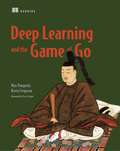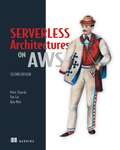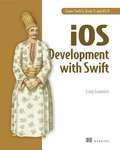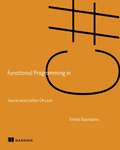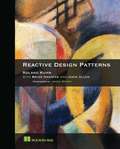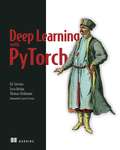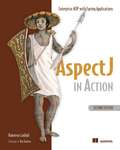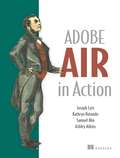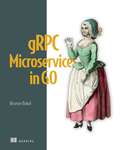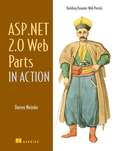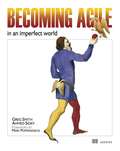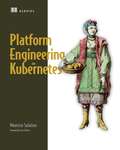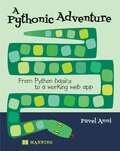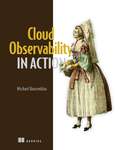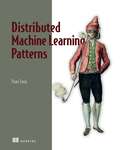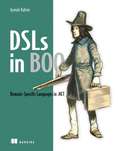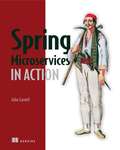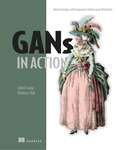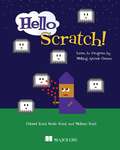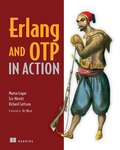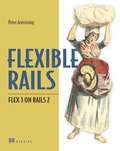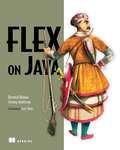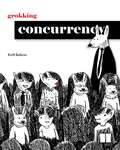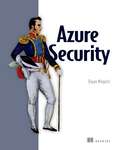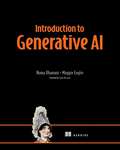- Table View
- List View
Deep Learning and the Game of Go
by Max Pumperla Kevin FergusonSummaryDeep Learning and the Game of Go teaches you how to apply the power of deep learning to complex reasoning tasks by building a Go-playing AI. After exposing you to the foundations of machine and deep learning, you'll use Python to build a bot and then teach it the rules of the game.Foreword by Thore Graepel, DeepMindPurchase of the print book includes a free eBook in PDF, Kindle, and ePub formats from Manning Publications.About the TechnologyThe ancient strategy game of Go is an incredible case study for AI. In 2016, a deep learning-based system shocked the Go world by defeating a world champion. Shortly after that, the upgraded AlphaGo Zero crushed the original bot by using deep reinforcement learning to master the game. Now, you can learn those same deep learning techniques by building your own Go bot!About the BookDeep Learning and the Game of Go introduces deep learning by teaching you to build a Go-winning bot. As you progress, you'll apply increasingly complex training techniques and strategies using the Python deep learning library Keras. You'll enjoy watching your bot master the game of Go, and along the way, you'll discover how to apply your new deep learning skills to a wide range of other scenarios!What's insideBuild and teach a self-improving game AIEnhance classical game AI systems with deep learningImplement neural networks for deep learningAbout the ReaderAll you need are basic Python skills and high school-level math. No deep learning experience required.About the AuthorMax Pumperla and Kevin Ferguson are experienced deep learning specialists skilled in distributed systems and data science. Together, Max and Kevin built the open source bot BetaGo.Table of ContentsPART 1 - FOUNDATIONSToward deep learning: a machine-learning introductionGo as a machine-learning problemImplementing your first Go botPART 2 - MACHINE LEARNING AND GAME AIPlaying games with tree searchGetting started with neural networksDesigning a neural network for Go dataLearning from data: a deep-learning botDeploying bots in the wildLearning by practice: reinforcement learningReinforcement learning with policy gradientsReinforcement learning with value methodsReinforcement learning with actor-critic methodsPART 3 - GREATER THAN THE SUM OF ITS PARTSAlphaGo: Bringing it all togetherAlphaGo Zero: Integrating tree search with reinforcement learning
Serverless Architectures on AWS, Second Edition
by Yan Cui Peter Sbarski Ajay NairDesign low-maintenance systems using pre-built cloud services! Bring down costs, automate time-consuming ops tasks, and scale on demand.In Serverless Architectures on AWS, Second Edition you will learn: First steps with serverless computing The principles of serverless design Important patterns and architectures How successfully companies have implemented serverless Real-world architectures and their tradeoffs Serverless Architectures on AWS, Second Edition teaches you how to design serverless systems. You&’ll discover the principles behind serverless architectures, and explore real-world case studies where companies used serverless architectures for their products. You won&’t just master the technical essentials—the book contains extensive coverage of balancing tradeoffs and making essential technical decisions. This new edition has been fully updated with new chapters covering current best practice, example architectures, and full coverage of the latest changes to AWS. About the technology Maintaining server hardware and software can cost a lot of time and money. Unlike traditional data center infrastructure, serverless architectures offload core tasks like data storage and hardware management to pre-built cloud services. Better yet, you can combine your own custom AWS Lambda functions with other serverless services to create features that automatically start and scale on demand, reduce hosting cost, and simplify maintenance. About the book In Serverless Architectures with AWS, Second Edition you&’ll learn how to design serverless systems using Lambda and other services on the AWS platform. You&’ll explore event-driven computing and discover how others have used serverless designs successfully. This new edition offers real-world use cases and practical insights from several large-scale serverless systems. Chapters on innovative serverless design patterns and architectures will help you become a complete cloud professional. What's inside First steps with serverless computing The principles of serverless design Important patterns and architectures Real-world architectures and their tradeoffs About the reader For server-side and full-stack software developers. About the author Peter Sbarski is VP of Education and Research at A Cloud Guru. Yan Cui is an independent AWS consultant and educator. Ajay Nair is one of the founding members of the AWS Lambda team. Table of Contents PART 1 FIRST STEPS 1 Going serverless 2 First steps to serverless 3 Architectures and patterns PART 2 USE CASES 4 Yubl: Architecture highlights, lessons learned 5 A Cloud Guru: Architecture highlights, lessons learned 6 Yle: Architecture highlights, lessons learned PART 3 PRACTICUM 7 Building a scheduling service for ad hoc tasks 8 Architecting serverless parallel computing 9 Code Developer University PART 4 THE FUTURE 10 Blackbelt Lambda 11 Emerging practices
iOS Development with Swift
by Craig GrummittSummaryiOS Development with Swift is a hands-on guide to creating apps for iPhone and iPad using the Swift language. Inside, you'll be guided through every step of the process for building an app, from first idea to App Store. This book fully covers Swift 4, Xcode 9, and iOS 1.Our video course, iOS Development with Swift in Motion, is the perfect companion to this book, featuring even more projects and examples for you to dig into in the exciting world of iOS development. Find out more at our website: www.manning.com/livevideo/ios-development-with-swift-lvPurchase of the print book includes a free eBook in PDF, Kindle, and ePub formats from Manning Publications.About the TechnologyOne billion iPhone users are waiting for the next amazing app. It's time for you to build it! Apple's Swift language makes iOS development easier than ever, offering modern language features, seamless integration with all iOS libraries, and the top-notch Xcode development environment. And with this book, you'll get started fast.About the BookiOS Development with Swift is a hands-on guide to creating iOS apps. It takes you through the experience of building an app—from idea to App Store. After setting up your dev environment, you'll learn the basics by experimenting in Swift playgrounds. Then you'll build a simple app layout, adding features like animations and UI widgets. Along the way, you'll retrieve, format, and display data; interact with the camera and other device features; and touch on cloud and networking basics. What's InsideCreate adaptive layoutsStore and manage dataLearn to write and debug Swift codePublish to the App StoreCovers Swift 4, Xcode 9, and iOS 11About the ReaderWritten for intermediate web or mobile developers. No prior experience with Swift assumed.About the AuthorCraig Grummitt is a successful developer, instructor, and mentor. His iOS apps have had over 100,000 downloads combined!Table of ContentsPART 1 - INTRODUCING XCODE AND SWIFT Your first iOS application Introduction to Swift playgrounds Swift objects PART 2 - BUILDING YOUR INTERFACE View controllers, views, and outlets User interaction Adaptive layout More adaptive layout Keyboard notifications, animation, and scrolling PART 3 - BUILDING YOUR APP Tables and navigation Collections, searching, sorting, and tab bars Local data persistence Data persistence in iCloud Graphics and media Networking Debugging and testingPART 4 - FINALIZING YOUR APP Distributing your app What's next?
Functional Programming in C#: How to write better C# code
by Enrico BuonannoSummaryFunctional Programming in C# teaches you to apply functional thinking to real-world problems using the C# language. The book, with its many practical examples, is written for proficient C# programmers with no prior FP experience. It will give you an awesome new perspective.Purchase of the print book includes a free eBook in PDF, Kindle, and ePub formats from Manning Publications.About the TechnologyFunctional programming changes the way you think about code. For C# developers, FP techniques can greatly improve state management, concurrency, event handling, and long-term code maintenance. And C# offers the flexibility that allows you to benefit fully from the application of functional techniques. This book gives you the awesome power of a new perspective.About the BookFunctional Programming in C# teaches you to apply functional thinking to real-world problems using the C# language. You'll start by learning the principles of functional programming and the language features that allow you to program functionally. As you explore the many practical examples, you'll learn the power of function composition, data flow programming, immutable data structures, and monadic composition with LINQ.What's InsideWrite readable, team-friendly codeMaster async and data streamsRadically improve error handlingEvent sourcing and other FP patternsAbout the ReaderWritten for proficient C# programmers with no prior FP experience.About the AuthorEnrico Buonanno studied computer science at Columbia University and has 15 years of experience as a developer, architect, and trainer.Table of ContentsPART 1 - CORE CONCEPTSIntroducing functional programmingWhy function purity matters Designing function signatures and types Patterns in functional programming Designing programs with function composition PART 2 - BECOMING FUNCTIONALFunctional error handling Structuring an application with functions Working effectively with multi-argument functions Thinking about data functionally Event sourcing: a functional approach to persistence PART 3 - ADVANCED TECHNIQUESLazy computations, continuations, and the beauty of monadic composition Stateful programs and stateful computations Working with asynchronous computations Data streams and the Reactive Extensions An introduction to message-passing concurrency
Reactive Design Patterns
by Jamie AllenSummaryReactive Design Patterns is a clearly written guide for building message-driven distributed systems that are resilient, responsive, and elastic. In this book you'll find patterns for messaging, flow control, resource management, and concurrency, along with practical issues like test-friendly designs. All patterns include concrete examples using Scala and Akka. Foreword by Jonas Bonér. Purchase of the print book includes a free eBook in PDF, Kindle, and ePub formats from Manning Publications.About the TechnologyModern web applications serve potentially vast numbers of users - and they need to keep working as servers fail and new ones come online, users overwhelm limited resources, and information is distributed globally. A Reactive application adjusts to partial failures and varying loads, remaining responsive in an ever-changing distributed environment. The secret is message-driven architecture - and design patterns to organize it.About the BookReactive Design Patterns presents the principles, patterns, and best practices of Reactive application design. You'll learn how to keep one slow component from bogging down others with the Circuit Breaker pattern, how to shepherd a many-staged transaction to completion with the Saga pattern, how to divide datasets by Sharding, and more. You'll even see how to keep your source code readable and the system testable despite many potential interactions and points of failure. What's InsideThe definitive guide to the Reactive ManifestoPatterns for flow control, delimited consistency, fault tolerance, and much moreHard-won lessons about what doesn't workArchitectures that scale under tremendous loadAbout the ReaderMost examples use Scala, Java, and Akka. Readers should be familiar with distributed systems.About the AuthorDr. Roland Kuhn led the Akka team at Lightbend and coauthored the Reactive Manifesto. Brian Hanafee and Jamie Allen are experienced distributed systems architects. Table of ContentsPART 1 - INTRODUCTIONWhy Reactive? A walk-through of the Reactive Manifesto Tools of the trade PART 2 - THE PHILOSOPHY IN A NUTSHELLMessage passing Location transparency Divide and conquer Principled failure handling Delimited consistency Nondeterminism by need Message flow PART 3 - PATTERNS Testing reactive applications Fault tolerance and recovery patterns Replication patterns Resource-management patterns Message flow patterns Flow control patterns State management and persistence patterns
Deep Learning with PyTorch
by Luca Pietro Antiga Eli Stevens Thomas Viehmann&“We finally have the definitive treatise on PyTorch! It covers the basics and abstractions in great detail. I hope this book becomes your extended reference document.&” —Soumith Chintala, co-creator of PyTorch Key Features Written by PyTorch&’s creator and key contributors Develop deep learning models in a familiar Pythonic way Use PyTorch to build an image classifier for cancer detection Diagnose problems with your neural network and improve training with data augmentation Purchase of the print book includes a free eBook in PDF, Kindle, and ePub formats from Manning Publications.About The Book Every other day we hear about new ways to put deep learning to good use: improved medical imaging, accurate credit card fraud detection, long range weather forecasting, and more. PyTorch puts these superpowers in your hands. Instantly familiar to anyone who knows Python data tools like NumPy and Scikit-learn, PyTorch simplifies deep learning without sacrificing advanced features. It&’s great for building quick models, and it scales smoothly from laptop to enterprise. Deep Learning with PyTorch teaches you to create deep learning and neural network systems with PyTorch. This practical book gets you to work right away building a tumor image classifier from scratch. After covering the basics, you&’ll learn best practices for the entire deep learning pipeline, tackling advanced projects as your PyTorch skills become more sophisticated. All code samples are easy to explore in downloadable Jupyter notebooks. What You Will Learn Understanding deep learning data structures such as tensors and neural networks Best practices for the PyTorch Tensor API, loading data in Python, and visualizing results Implementing modules and loss functions Utilizing pretrained models from PyTorch Hub Methods for training networks with limited inputs Sifting through unreliable results to diagnose and fix problems in your neural network Improve your results with augmented data, better model architecture, and fine tuning This Book Is Written For For Python programmers with an interest in machine learning. No experience with PyTorch or other deep learning frameworks is required. About The Authors Eli Stevens has worked in Silicon Valley for the past 15 years as a software engineer, and the past 7 years as Chief Technical Officer of a startup making medical device software. Luca Antiga is co-founder and CEO of an AI engineering company located in Bergamo, Italy, and a regular contributor to PyTorch. Thomas Viehmann is a Machine Learning and PyTorch speciality trainer and consultant based in Munich, Germany and a PyTorch core developer. Table of Contents PART 1 - CORE PYTORCH 1 Introducing deep learning and the PyTorch Library 2 Pretrained networks 3 It starts with a tensor 4 Real-world data representation using tensors 5 The mechanics of learning 6 Using a neural network to fit the data 7 Telling birds from airplanes: Learning from images 8 Using convolutions to generalize PART 2 - LEARNING FROM IMAGES IN THE REAL WORLD: EARLY DETECTION OF LUNG CANCER 9 Using PyTorch to fight cancer 10 Combining data sources into a unified dataset 11 Training a classification model to detect suspected tumors 12 Improving training with metrics and augmentation 13 Using segmentation to find suspected nodules 14 End-to-end nodule analysis, and where to go next PART 3 - DEPLOYMENT 15 Deploying to production
AspectJ in Action: Enterprise AOP with Spring Applications
by Raminvas LaddadTo allow the creation of truly modular software, OOP has evolved into aspect-oriented programming. AspectJ is a mature AOP implementation for Java, now integrated with Spring.AspectJ in Action, Second Edition is a fully updated, major revision of Ramnivas Laddad's best-selling first edition. It's a hands-on guide for Java developers. After introducing the core principles of AOP, it shows you how to create reusable solutions using AspectJ 6 and Spring 3. You'll master key features including annotation-based syntax, load-time weaver, annotation-based crosscutting, and Spring-AspectJ integration. Building on familiar technologies such as JDBC, Hibernate, JPA, Spring Security, Spring MVC, and Swing, you'll apply AOP to common problems encountered in enterprise applications.This book requires no previous experience in AOP and AspectJ, but it assumes you're familiar with OOP, Java, and the basics of Spring."Clear, concisely worded, well-organized ... a pleasure to read."-From the Foreword by Rod Johnson, Creator of the Spring Framework"This book teaches you how to think in aspects. It is essential reading for both beginners who know nothing about AOP and experts who think they know it all."- Andrew Eisenberg, AspectJ Development Tools Project Committer"Ramnivas showcases how to get the best out of AspectJ and Spring."-Andy Clement, AspectJ Project Lead"One of the best Java books in years."-Andrew Rhine, Software Engineer, eSecLending"By far the best reference for Spring AOP and AspectJ."-Paul Benedict, Software Engineer, Argus Health Systems"Ramnivas expertly demystifies the awesome power of aspect-oriented programming."-Craig Walls, author of Spring in Action
Adobe AIR in Action
by Ashley Atkins Samuel Ahn Joseph Lott Kathryn RotondoAdobe AIR is one of the hottest topics in rich application development. This exciting new technology is still in beta, but it's already being adopted by such web giants as eBay. With AIR, Web developers use their existing skills to build rich applications that flow seamlessly between the internet and the desktop.Adobe AIR in Action introduces AIR to developers familiar with Flex and JavaScript, showing them how to build solid AIR-driven desktop and hybrid applications. Using small examples, the expert authors walk web developers through the new topics they will need to develop AIR applications for the desktop. Readers will learn the essential features of the AIR API with examples and code samples that web professionals can use to get up and running in AIR quickly. The book describes how to create and customize native windows, read and write files and folders on the local file system.Web developers who read this book will be able to take instant advantage of the increased resources available to desktop applications. Sometimes-connected, web-enabled applications are gaining in popularity, and web developers of all stripes will want to add these skills to their toolbox. Purchase of the print book comes with an offer of a free PDF, ePub, and Kindle eBook from Manning. Also available is all code from the book.
gRPC Microservices in Go
by Hüseyin BabalBuild super fast and super secure microservices with the gRPC high-performance messaging protocol and powerful Go language.In gRPC Microservices in Go you&’ll learn: Designing and implementing resilient microservice architecture Testing microservices Deploying microservices to the cloud with modern orchestration tools Monitoring and overseeing microservices The powerful gRPC Remote Procedure Call framework delivers superior speed and security over protocols like REST. When paired with Golang&’s low-level efficiency and flexibility, gRPC and Go become a killer combination for latency-sensitive microservices applications. gRPC Microservices in Go shows you how to utilize these powerful tools to build production-grade microservices. You&’ll learn to develop microservice inter-service communication patterns that are powered by gRPC, design backward compatible APIs, and apply hexagonal architecture to microservices. About the technology Go is perfect for writing fast, reliable microservices code, but that&’s only half the story. You also need a communications framework like gRPC to connect your services and handle load balancing, tracing, health checking, and authentication. Together, Go and gRPC accelerate the development process and eliminate many of the challenges you face when building and deploying microservices. About the book gRPC Microservices in Go teaches you how to build production-ready microservices using Go and gRPC. In it, you&’ll learn to create efficient APIs in Go, use gRPC for network communication, and deploy on cloud and Kubernetes. Helpful examples, including a complete eCommerce web app, make it easy to grasp each concept. You&’ll also get an inside look at testing, deployment, and efficient DevOps practices for microservices. What's inside Designing and implementing resilient microservice architecture Testing microservices Cloud deploying microservices with orchestration tools Monitoring and overseeing microservices About the reader For software developers who know the basics of Go. About the author Hüseyin Babal has been using Go in production since 2017 to build and maintain SaaS platforms. Table of Contents PART 1 - GRPC AND MICROSERVICES ARCHITECTURE 1 Introduction to Go gRPC microservices 2 gRPC meets microservices PART 2 - DEVELOPING, TESTING, AND DEPLOYING A GRPC MICROSERVICE APPLICATION 3 Getting up and running with gRPC and Golang 4 Microservice project setup 5 Interservice communication 6 Resilient communication 7 Testing microservices 8 Deployment PART 3 - GRPC AND MICROSERVICES ARCHITECTURE 9 Observability
ASP.NET 2.0 Web Parts in Action: Building Dynamic Web Portals
by Darren NeimkeA must-buy for every ASP.NET developer using Web Parts.Scott GuthrieGeneral ManagerMicrosoft Developer Division"Squeezes the full potential out of ASP.NET Web Parts."Andres SanabriaLead Program ManagerASP.NET and Server Application FrameworksUsing Web Parts, ASP.NET developers can create portals with the same advanced features found in sites such as Live.com and Google ig.ASP.NET 2.0 Web Parts in Action demystifies portal design, development, maintenance, and deployment. In over 400 code-packed pages, ASP.NET expert Darren Neimke shares his deep understanding of the controls and services that make up the portal framework.This book will help you to code like a guru but think like a user. For example, you'll discover how to use Web Parts to reduce four-step actions to a single click with a strategically-placed edit button. Learn to balance features and usability to make your portals both look good and work well.ASP.NET 2.0 Web Parts in Action gives you the tools you need to move your ideas off the whiteboard and bring them to life. Find out how to provide the personalization options your users want while preserving the look and feel of your portals with solid designs and custom chrome. Create usable information dashboards and tackle tough interoperability questions with confidence.All the information in this book is performance-tested. Author Darren Neimke walks you through Web Parts concepts including static and dynamic connections, WebPartManager, SQLPersonalizationProvider, and the hot new ASP.NET Atlas framework.Whether you're creating custom solutions or adding Web Parts to SharePoint 2007, exploring Atlas or dabbling in gadgets, ASP.NET 2.0 Web Parts in Action will get you started and guide you as you build successful portals using ASP.NET Web Parts. Purchase of the print book comes with an offer of a free PDF, ePub, and Kindle eBook from Manning. Also available is all code from the book.
Becoming Agile: ...in an imperfect world
by Greg Smith Ahmed SidkyMany books discuss Agile from a theoretical or academic perspective. Becoming Agile takes a different approach and focuses on explaining Agile from a case-study perspective. Agile principles are discussed, explained, and then demonstrated in the context of a case study that flows throughout the book. The case study is based on a mixture of the author's real-world experiences.Becoming Agile also focuses on the importance of adapting Agile principles to the realities of your environment. In the early days of Agile, there was a general belief that Agile had to be used in all phases of a project, and that it had to be used in its purest form. Over the last few years, reputable Agile authorities have begun questioning this belief: We're finding that the best deployments of Agile are customized to the realities of a given company.Becoming Agile discusses the cultural realities of deploying Agile and how to deal with the needs of executives, managers, and the development team during migration. The author discusses employee motivation and establishing incentives that reward support of Agile techniques. Purchase of the print book comes with an offer of a free PDF, ePub, and Kindle eBook from Manning. Also available is all code from the book. Praise for Becoming Agile..."This is much more than just a book about Agile. This is a roadmap. A very detailed roadmap that takes you from the initial "is Agile right for me?" stage through completion and delivery of your pilot project and beyond."-Charlie Griefer, Senior Software Engineer, Amcom Technology"...a must read for those of us who have come from years of waterfall and attempts at changes to "traditional" methodologies or processes... clear, concise and has plenty of example scenarios that many individuals and corporations would identify with."-Jamie Phillips, Senior Software Engineer, Picis Inc"This book is quite unique. It is written in a form of a 5-day training course. I am usually not a fan of such a writing style, but I think that Becoming Agile is an exception. It's about a software process and as such requires a lot of case studies, group exercises (or at least what a book format allows), and therefore the training course style is perfect to facilitate learning."-Vladimir Pasman, Cocoacast.com"Becoming Agile in an Imperfect World offers a different and useful look at Agile methods. Reminding us that becoming agile is more of a mindset adjustment than a process change, Sidky and Smith use a case study to share their insights and tools throughout the book, including the unique Sidky Agile Measurement Index (SAMI)."-Sanjiv Augustine, President, LitheSpeed LLC and author of Managing Agile Projects"The authors emphasise that the aim should be to create a customised agile development process that is tailored to the needs of the organisation...Instead of aiming for "agile perfection", one should aim at reaching the right level of agility for one's organisation. Excellent advice!"-Kailash Awati, Eight to Late"The book totally inspired me. A lot of my readings on Agile from back in the day were very theoretical and high level at the same time. But Becoming Agile helps take you to the next level by going beyond the theory and into the nitty gritty practicality of employing the Agile approach. So it was very energizing having the game plan laid out in front of you, as well as the hurdles you'll encounter and how to overcome them."-Tariq Ahmed, author of Flex 3 in Action
Platform Engineering on Kubernetes
by Mauricio SalatinoEmpower your team with platforms built on top of Kubernetes using open source tools.Adopting Kubernetes is complex—especially when you&’re working in an organization with multiple teams, deploying to multiple cloud providers, and working with different stacks. Platform Engineering on Kubernetes shows you how to solve these common cloud native problems with open-source tools and emerging best practices from the Kubernetes community. In Platform Engineering on Kubernetes you will learn about: The principles behind platform engineering and how these apply to Kubernetes Evaluating and adopting open-source projects to build domain specific platforms Creating Platform APIs to enable teams to release more software more efficiently Reducing the cognitive load of a platform for your teams Measuring your platform initiatives using established software delivery metrics Package, version, distribute, and deploy with Helm, Tekton, Dagger and Argo CD Implement a multi-cloud infrastructure strategy using Crossplane Progressive upgrades with Knative Serving and Argo Rollouts Enable development teams with standard application-level APIs with Dapr A platform helps your team stay focused on delivering amazing software. But building a reliable platform on top of Kubernetes demands real expertise. Platform Engineering on Kubernetes reveals how to combine multiple popular open-source projects into a custom platform that works for your applications and your teams. It&’s the perfect guide for your organization&’s journey to Kubernetes, simplifying cloud native development for your dev teams and helping them deliver software faster. Foreword by Jared Watts. About the technology Kubernetes is an amazing orchestration tool, but it&’s just the start of your journey to the cloud. To efficiently deliver cloud-native software, your team needs a solid build pipeline, an efficient package manager and distribution mechanism, and APIs that reduce your team&’s cognitive load. This book will show you how to build custom platforms on top of Kubernetes—all with open-source tools such as Dapr, Knative, Argo CD and Rollouts, and Tekton. About the book Platform Engineering on Kubernetes starts by clearly defining the elements of a great Kubernetes-based platform. Then, it systematically introduces the tools you&’ll need to build a platform that exactly matches your organization&’s requirements. Hands-on examples and detailed code guide you through each step. By the end, you&’ll be able to create a complete platform to efficiently deliver cloud-native software without being tied to a specific cloud provider or vendor. About the reader For developers and software architects familiar with the basics of containers and Kubernetes. About the author Mauricio Salatino is currently a Dapr OSS Contributor, a Knative Steering Committee member, and co-lead of the Knative Functions working group. Table of Contents 1 (The rise of) platforms on top of Kubernetes 2 Cloud-native application challenges 3 Service pipelines: Building cloud-native applications 4 Environment pipelines: Deploying cloud-native applications 5 Multi-cloud (app) infrastructure 6 Let&’s build a platform on top of Kubernetes 7 Platform capabilities I: Shared application concerns 8 Platform capabilities II: Enabling teams to experiment 9 Measuring your platforms
A Pythonic Adventure: From Python basics to a working web app
by Pavel AnniTime to take an adventure with friends! Team up with Erik and Simon to learn Python the easy way. This colorful book uses engaging questions and lively conversations to introduce computer programming to young readers one step at a time.In A Pythonic Adventure, you will learn useful Python skills like: Installing Python Working with files Creating text-based dialogs and menus Using if/then, loops, lists, dictionaries, and input/output Building web applications Making your web apps look super professional It&’s fun to learn with friends! In A Pythonic Adventure you&’ll meet Erik and Simon, two brothers who are just beginning their Python journey. Join them as they chat about the language, learn the basics, and build some cool programs. The book&’s dialogue helps young programmers understand complex concepts much more easily. It's the perfect way for young programmers (and their parents) to get started. There&’s no boring lessons or dull exercises in this adventure. You&’ll follow Erik and Simon&’s questions and mistakes, discover how to write programs with a team, and get a chance to create applications you can use in your daily life. By the time they&’re done reading, young learners will not only know how to write code, they&’ll know how to think about problems like professional developers. All code in this book runs on Mac, Windows, Linux, and Raspberry Pi. About the technology Computer programming is an adventure, full of new experiences, challenges, triumphs, and mistakes. In A Pythonic Adventure, you&’ll join brothers Erik and Simon as they learn to create their first Python program. Written especially for young readers, this book is the perfect introduction to a skill that will last a lifetime! About the book A Pythonic Adventure teaches you to code by asking questions, making errors, and trying out different solutions—just like in real life. As you go, you&’ll create a web application for a coffee shop step-by-step, from your first online menu to saving orders in a database. And this unique tutorial goes deeper than other beginner books. You&’ll learn and practice important skills like planning applications, finding bugs, and managing user expectations. What's inside Installing Python Creating text-based dialogs and menus Building web applications Making your web apps look professional About the reader For readers aged 10+. Perfect for adult beginners, too! About the author Pavel Anni is a Principal Customer Engineer at SambaNova Systems, and has also worked for Sun Microsystems, Oracle, and Red Hat. Table of Contents 1 Coffee for friends: First steps 2 Lists: What&’s on the menu? 3 Functions: Don&’t repeat yourself! 4 User errors: Everybody makes mistakes 5 Working with files: Being a shop manager 6 Main menu: Next customer! 7 Creating functions: Get the order and print it 8 Working with JSON: Save the order 9 Complete the menu: A real program 10 Learning Flask: Your first web application 11 Web form for orders: Coffee shop on the web 12 Database: We need good storage 13 Styles: Making it pretty 14 Help from AI: Improving our code 15 Next steps: Plans for the future
Cloud Observability in Action (In Action)
by Michael HausenblasDon&’t fly blind. Observability gives you actionable insights into your cloud native systems—from pinpointing errors, to increasing developer productivity, to tracking compliance.Observability is the difference between an error message and an error explanation with a recipe how to resolve the error! You know exactly which service is affected, who&’s responsible for its repair, and even how it can be optimized in the future. Cloud Observability in Action teaches you how to set up an observability system that learns from a cloud application&’s signals, logging, and monitoring, all using free and open source tools. In Cloud Observability in Action you will learn how to: Apply observability in cloud native systems Understand observability signals, including their costs and benefits Apply good practices around instrumentation and signal collection Deliver dashboarding, alerting, and SLOs/SLIs at scale Choose the correct signal types for given roles or tasks Pick the right observability tool for any given function Communicate the benefits of observability to management A well-designed observability system provides insight into bugs and performance issues in cloud native applications. They help your development team understand the impact of code changes, measure optimizations, and track user experience. Best of all, observability can even automate your error handling so that machine users apply their own fixes—no more 3AM calls for emergency outages. About the technology Cloud native systems are made up of hundreds of moving parts. When something goes wrong, it&’s not enough to know there is a problem—you need to know where it is, what it is, and how to fix it. This book takes you beyond traditional monitoring, explaining observability systems that turn application telemetry into actionable insights. About the book Cloud Observability in Action gives you the background and techniques you need to successfully introduce observability into cloud-based serverless and Kubernetes environments. In it, you&’ll learn to use open standards and tools like OpenTelemetry, Prometheus, and Grafana to build your own observability system and end reliance on proprietary software. You&’ll discover insights from different telemetry signals, including logs, metrics, traces, and profiles. Plus, the book&’s rigorous cost-benefit analysis ensures you&’re getting a real return on your observability investment. What's inside Observability in and of cloud native systems Dashboarding, alerting, and SLOs/SLIs at scale Signal types for any role or task State-of-the-art open source observability tools About the reader For application developers, platform owners, DevOps, and SREs. About the author Michael Hausenblas is a Product Owner in the AWS open source observability team. Table of Contents 1 End-to-end observability 2 Signal types 3 Sources 4 Agents and instrumentation 5 Backend destinations 6 Frontend destinations 7 Cloud operations 8 Distributed tracing 9 Developer observability 10 Service level objectives 11 Signal correlation
Distributed Machine Learning Patterns
by Yuan TangPractical patterns for scaling machine learning from your laptop to a distributed cluster.Distributing machine learning systems allow developers to handle extremely large datasets across multiple clusters, take advantage of automation tools, and benefit from hardware accelerations. This book reveals best practice techniques and insider tips for tackling the challenges of scaling machine learning systems. In Distributed Machine Learning Patterns you will learn how to: Apply distributed systems patterns to build scalable and reliable machine learning projects Build ML pipelines with data ingestion, distributed training, model serving, and more Automate ML tasks with Kubernetes, TensorFlow, Kubeflow, and Argo Workflows Make trade-offs between different patterns and approaches Manage and monitor machine learning workloads at scale Inside Distributed Machine Learning Patterns you&’ll learn to apply established distributed systems patterns to machine learning projects—plus explore cutting-edge new patterns created specifically for machine learning. Firmly rooted in the real world, this book demonstrates how to apply patterns using examples based in TensorFlow, Kubernetes, Kubeflow, and Argo Workflows. Hands-on projects and clear, practical DevOps techniques let you easily launch, manage, and monitor cloud-native distributed machine learning pipelines. About the technology Deploying a machine learning application on a modern distributed system puts the spotlight on reliability, performance, security, and other operational concerns. In this in-depth guide, Yuan Tang, project lead of Argo and Kubeflow, shares patterns, examples, and hard-won insights on taking an ML model from a single device to a distributed cluster. About the book Distributed Machine Learning Patterns provides dozens of techniques for designing and deploying distributed machine learning systems. In it, you&’ll learn patterns for distributed model training, managing unexpected failures, and dynamic model serving. You&’ll appreciate the practical examples that accompany each pattern along with a full-scale project that implements distributed model training and inference with autoscaling on Kubernetes. What's inside Data ingestion, distributed training, model serving, and more Automating Kubernetes and TensorFlow with Kubeflow and Argo Workflows Manage and monitor workloads at scale About the reader For data analysts and engineers familiar with the basics of machine learning, Bash, Python, and Docker. About the author Yuan Tang is a project lead of Argo and Kubeflow, maintainer of TensorFlow and XGBoost, and author of numerous open source projects. Table of Contents PART 1 BASIC CONCEPTS AND BACKGROUND 1 Introduction to distributed machine learning systems PART 2 PATTERNS OF DISTRIBUTED MACHINE LEARNING SYSTEMS 2 Data ingestion patterns 3 Distributed training patterns 4 Model serving patterns 5 Workflow patterns 6 Operation patterns PART 3 BUILDING A DISTRIBUTED MACHINE LEARNING WORKFLOW 7 Project overview and system architecture 8 Overview of relevant technologies 9 A complete implementation
DSLs in Boo: Domain Specific Languages in .NET
by Oren EiniA general-purpose language like C# is designed to handle all programming tasks. By contrast, the structure and syntax of a Domain-Specific Language are designed to match a particular applications area. A DSL is designed for readability and easy programming of repeating problems. Using the innovative Boo language, it's a breeze to create a DSL for your application domain that works on .NET and does not sacrifice performance. DSLs in Boo shows you how to design, extend, and evolve DSLs for .NET by focusing on approaches and patterns. You learn to define an app in terms that match the domain, and to use Boo to build DSLs that generate efficient executables. And you won't deal with the awkward XML-laden syntax many DSLs require. The book concentrates on writing internal (textual) DSLs that allow easy extensibility of the application and framework. And if you don't know Boo, don't worry-you'll learn right here all the techniques you need. Purchase of the print book comes with an offer of a free PDF, ePub, and Kindle eBook from Manning. Also available is all code from the book.
Spring Microservices in Action
by John Carnell Kalpit PatelSummarySpring Microservices in Action teaches you how to build microservice-based applications using Java and the Spring platform. Purchase of the print book includes a free eBook in PDF, Kindle, and ePub formats from Manning Publications.About the technologyMicroservices break up your code into small, distributed, and independent services that require careful forethought and design. Fortunately, Spring Boot and Spring Cloud simplify your microservice applications, just as the Spring Framework simplifies enterprise Java development. Spring Boot removes the boilerplate code involved with writing a REST-based service. Spring Cloud provides a suite of tools for the discovery, routing, and deployment of microservices to the enterprise and the cloud.About the BookSpring Microservices in Action teaches you how to build microservice-based applications using Java and the Spring platform. You'll learn to do microservice design as you build and deploy your first Spring Cloud application. Throughout the book, carefully selected real-life examples expose microservice-based patterns for configuring, routing, scaling, and deploying your services. You'll see how Spring's intuitive tooling can help augment and refactor existing applications with micro services.What's InsideCore microservice design principlesManaging configuration with Spring Cloud ConfigClient-side resiliency with Spring, Hystrix, and RibbonIntelligent routing using Netflix ZuulDeploying Spring Cloud applicationsAbout the ReaderThis book is written for developers with Java and Spring experience.About the AuthorJohn Carnell is a senior cloud engineer with twenty years of experience in Java.Table of contentsWelcome to the cloud, Spring Building microservices with Spring Boot Controlling your configuration with Spring Cloud configuration server On service discovery When bad things happen: client resiliency patterns with Spring Cloud and Netflix Hystrix Service routing with Spring Cloud and Zuul Securing your microservices Event-driven architecture with Spring Cloud Stream Distributed tracing with Spring Cloud Sleuth and Zipkin Deploying your microservices
GANs in Action: Deep learning with Generative Adversarial Networks
by Vladimir Bok Jakub LangrDeep learning systems have gotten really great at identifying patterns in text, images, and video. But applications that create realistic images, natural sentences and paragraphs, or native-quality translations have proven elusive. Generative Adversarial Networks, or GANs, offer a promising solution to these challenges by pairing two competing neural networks' one that generates content and the other that rejects samples that are of poor quality. GANs in Action: Deep learning with Generative Adversarial Networks teaches you how to build and train your own generative adversarial networks. First, you'll get an introduction to generative modelling and how GANs work, along with an overview of their potential uses. Then, you'll start building your own simple adversarial system, as you explore the foundation of GAN architecture: the generator and discriminator networks.Purchase of the print book includes a free eBook in PDF, Kindle, and ePub formats from Manning Publications.
Hello Scratch!: Learn to program by making arcade games
by Melissa FordSummaryHello, Scratch! is a how-to book that helps parents and kids work together to learn programming skills by creating new versions of old retro-style arcade games with Scratch.Purchase of the print book includes a free eBook in PDF, Kindle, and ePub formats from Manning Publications.About the TechnologyCan 8-year-olds write computer programs? You bet they can! In Scratch, young coders use colorful blocks and a rich graphical environment to create programs. They can easily explore ideas like input and output, looping, branching, and conditionals. Scratch is a kid-friendly language created by MIT that is a safe and fun way to begin thinking like a programmer, without the complexity of a traditional programming language.About the BookHello Scratch! guides young readers through five exciting games to help them take their first steps in programming. They'll experiment with key ideas about how a computer program works and enjoy the satisfaction of immediate success. These carefully designed projects give readers plenty of room to explore by imagining, tinkering, and personalizing as they learn.What's InsideLearn by experimentationLearn to think like a programmerBuild five exciting, retro-style gamesVisualize the organization of a programAbout the ReadersWritten for kids 8-14. Perfect for independent learning or working with a parent or teacher.About the AuthorsKids know how kids learn. Sadie and Gabriel Ford, 12-year-old twins and a formidable art and coding team, wrote this book with editing help from their mother, author Melissa Ford!Table of ContentsPART 1 - SETTING UP THE ARCADEGetting to know your way around ScratchBecoming familiar with the Art EditorMeeting Scratch's key blocks through important coding conceptsPART 2 - TURNING ON THE MACHINESDesigning a two-player ball-and-paddle gameUsing conditionals to build a two-player ball-and-paddle gamePART 3 - CODING AND PLAYING GAMESDesigning a fixed shooterUsing conditionals to build your fixed shooterDesigning a one-player ball-and-paddle gameUsing variables to build your one-player ball-and-paddle gameDesigning a simple platformerUsing X and Y coordinates to make a simple platformerMaking a single-screen platformerUsing arrays and simulating gravity in a single-screen platformerBecoming a game maker
Erlang and OTP in Action
by Eric Merritt Martin Logan Richard CarlssonConcurrent programming has become a required discipline for all programmers. Multi-core processors and the increasing demand for maximum performance and scalability in mission-critical applications have renewed interest in functional languages like Erlang that are designed to handle concurrent programming. Erlang, and the OTP platform, make it possible to deliver more robust applications that satisfy rigorous uptime and performance requirements.Erlang and OTP in Action teaches you to apply Erlang's message passing model for concurrent programming--a completely different way of tackling the problem of parallel programming from the more common multi-threaded approach. This book walks you through the practical considerations and steps of building systems in Erlang and integrating them with real-world C/C++, Java, and .NET applications. Unlike other books on the market, Erlang and OTP in Action offers a comprehensive view of how concurrency relates to SOA and web technologies.This hands-on guide is perfect for readers just learning Erlang or for those who want to apply their theoretical knowledge of this powerful language. You'll delve into the Erlang language and OTP runtime by building several progressively more interesting real-world distributed applications. Once you are competent in the fundamentals of Erlang, the book takes you on a deep dive into the process of designing complex software systems in Erlang. Purchase of the print book comes with an offer of a free PDF, ePub, and Kindle eBook from Manning. Also available is all code from the book.
Flexible Rails: Flex 3 on Rails 2
by Peter ArmstrongFlexible Rails is a unique, application-based guide for using Ruby on Rails 2 and Adobe Flex 3 to build rich Internet applications (RIAs). It is not an exhaustive Ruby on Rails or Flex reference. Instead, it is an extensive tutorial in which the reader builds multiple iterations of an interesting RIA using Flex and Rails together.Author Peter Armstrong walks readers through eleven iterations in which the sample application—pomodo—is variously built, refactored, debugged, sliced, diced and otherwise explored from every conceivable angle with respect to Ruby on Rails and Adobe Flex. The book unfolds both the application and the Flex-on-Rails approach side-by-side. Purchase of the print book comes with an offer of a free PDF, ePub, and Kindle eBook from Manning. Also available is all code from the book.
Flex on Java
by Jeremy Anderson Bernerd AllmonUnlike many Flex books that presume readers want to develop applications from scratch, Flex on Java is for developers in the real world-where Flex is one more technology being added to existing systems developed in Java, and where integration is the key indicator of success.Written for Java developers beginning to use Flex, Flex on Java shows how to use Flex alongside existing Java applications, and how to integrate Flex using familiar server-side technologies such as Spring, EJBs, JMS, and more. The authors, both Agile development experts, focus on Agile and test-driven development to enable readers to redesign applications that deliver more value and with zero defects. Throughout the book, readers will apply these techniques to refactoring a single application into a rich internet application using Flex and the BlazeDS framework. Purchase of the print book comes with an offer of a free PDF, ePub, and Kindle eBook from Manning. Also available is all code from the book.
Grokking Concurrency
by Kiril BobrovThis easy-to-read, hands-on guide demystifies concurrency concepts like threading, asynchronous programming, and parallel processing in any language.Perplexed by concurrency? Don&’t be. This engaging, fully-illustrated beginner&’s guide gets you writing the kind of high-performance code your apps deserve. Inside, you&’ll find thorough explanations of concurrency&’s core concepts—all explained with interesting illustrations, insightful examples, and detailed techniques you can apply to your own projects. In Grokking Concurrency you will: Get up to speed with the core concepts of concurrency, asynchrony, and parallel programming Learn the strengths and weaknesses of different hardware architectures Improve the sequential performance characteristics of your software Solve common problems for concurrent programming Compose patterns into a series of practices for writing scalable systems Write and implement concurrency systems that scale to any size Discover effective concurrency practices that will help you leverage multiple cores, excel with high loads, handle terabytes of data, and continue working after hardware and software failures. The core concepts in this guide will remain eternally relevant, whether you&’re building web apps, IoT systems, or handling big data. About the technology Concurrency is an approach to running computer programs efficiently by separating them into tasks that can execute independently. This basic idea makes it possible to accelerate game graphics, train large AI models, rapidly scale web applications, streamline big data processing, and much more. Concurrency can get complicated, so this book gets you started gently with interesting examples, entertaining illustrations, and easy-to-follow Python code. About the book Grokking Concurrency is a perfectly paced introduction to the fundamentals of concurrent, parallel, and asynchronous programming. In it, you&’ll learn the practices you&’ll need to program multicore processors, GPUs, and other high-performance systems. Author Kirill Bobrov skips the math, jargon, and academic language and concentrates on clear, plain-English explanations. What's inside Writing and running concurrent programs Patterns for performance, scalability, and resilience Choosing the right hardware Asynchronous communication About the reader Examples in Python. No prior experience with concurrency or high-performance computing required. About the author Kirill Bobrov is a software engineer with a passion for data engineering. Table of Contents Part 1 The Octopus Orchestra: Introduction to a Symphony of Concurrency 1 Introducing concurrency 2 Serial and parallel execution 3 How computers work 4 Building blocks of concurrency 5 Interprocess communication Part 2 the Many Tentacles of Concurrency: Multitasking, Decomposition, and Synchronization 6 Multitasking 7 Decomposition 8 Solving concurrency problems: Race conditions and synchronization 9 Solving concurrency problems: Deadlocks and starvation Part 3 Asynchronous Octopuses: a Pizza-making Tale of Concurrency 10 Nonblocking I/O 11 Event-based concurrency 12 Asynchronous communication 13 Writing concurrent applications
Azure Security
by Bojan MagusicSecure your Azure applications the right way. The expert DevSecOps techniques you'll learn in this essential handbook make it easy to keep your data safe.As a Program Manager at Microsoft, Bojan Magusic has helped numerous Fortune 500 companies improve their security posture in Azure. Now, in Azure Security he brings his experience from the cyber security frontline to ensure your Azure cloud-based systems are safe and secure. In Azure Security you&’ll learn vital security skills, including how to: Set up secure access through Conditional Access policiesImplement Azure WAF on Application Gateway and Front Door Deploy Azure Firewall Premium for monitoring network activities Enable Microsoft Defender for Cloud to assess workload configurations Utilize Microsoft Sentinel for threat detection and analytics Establish Azure Policy for compliance with business rules Correctly set up out-of-the-box Azure services to protect your web apps against both common and sophisticated threats, learn to continuously assess your systems for vulnerabilities, and discover cutting-edge operations for security hygiene, monitoring, and DevSecOps. Each stage is made clear and easy to follow with step-by-step instructions, complemented by helpful screenshots and diagrams. About the technology Securing cloud-hosted applications requires a mix of tools, techniques, and platform-specific services. The Azure platform provides built-in security tools to keep your systems safe, but proper implementation requires a foundational strategy and tactical guidance. About the book Azure Security details best practices for configuring and deploying Azure&’s native security services—from a zero-trust foundation to defense in depth (DiD). Learn from a Microsoft security insider how to establish a DevSecOps program using Microsoft Defender for Cloud. Realistic scenarios and hands-on examples help demystify tricky security concepts, while clever exercises help reinforce what you&’ve learned. What's inside Set up secure access policies Implement a Web Application Firewall Deploy MS Sentinel for monitoring and threat detection Establish compliance with business rules About the reader For software and security engineers building and securing Azure applications. About the author Bojan Magusic is a Product Manager with Microsoft on the Security Customer Experience Engineering Team. Table of Contents PART 1 FIRST STEPS 1 About Azure security 2 Securing identities in Azure: The four pillars of identity and Azure Active Directory PART 2 SECURING AZURE RESOURCES 3 Implementing network security in Azure: Firewall, WAF, and DDoS protection 4 Securing compute resources in Azure: Azure Bastion, Kubernetes, and Azure App Service 5 Securing data in Azure Storage accounts: Azure Key Vault 6 Implementing good security hygiene: Microsoft Defender for Cloud and Defender CSPM 7 Security monitoring for Azure resources: Microsoft Defender for Cloud plans PART 3 GOING FURTHER 8 Security operations and response: Microsoft Sentinel 9 Audit and log data: Azure Monitor 10 Importance of governance: Azure Policy and Azure Blueprints 11 DevSecOps: Microsoft Defender for DevOps
Introduction to Generative AI
by Numa DhamaniGenerative AI tools like ChatGPT are amazing—but how will their use impact our society? This book introduces the world-transforming technology and the strategies you need to use generative AI safely and effectively.Introduction to Generative AI gives you the hows-and-whys of generative AI in accessible language. In this easy-to-read introduction, you&’ll learn: How large language models (LLMs) work How to integrate generative AI into your personal and professional workflows Balancing innovation and responsibility The social, legal, and policy landscape around generative AI Societal impacts of generative AI Where AI is going Anyone who uses ChatGPT for even a few minutes can tell that it&’s truly different from other chatbots or question-and-answer tools. Introduction to Generative AI guides you from that first eye-opening interaction to how these powerful tools can transform your personal and professional life. In it, you&’ll get no-nonsense guidance on generative AI fundamentals to help you understand what these models are (and aren&’t) capable of, and how you can use them to your greatest advantage. Foreword by Sahar Massachi. About the technology Generative AI tools like ChatGPT, Bing, and Bard have permanently transformed the way we work, learn, and communicate. This delightful book shows you exactly how Generative AI works in plain, jargon-free English, along with the insights you&’ll need to use it safely and effectively. About the book Introduction to Generative AI guides you through benefits, risks, and limitations of Generative AI technology. You&’ll discover how AI models learn and think, explore best practices for creating text and graphics, and consider the impact of AI on society, the economy, and the law. Along the way, you&’ll practice strategies for getting accurate responses and even understand how to handle misuse and security threats. What's inside How large language models work Integrate Generative AI into your daily work Balance innovation and responsibility About the reader For anyone interested in Generative AI. No technical experience required. About the author Numa Dhamani is a natural language processing expert working at the intersection of technology and society. Maggie Engler is an engineer and researcher currently working on safety for large language models. The technical editor on this book was Maris Sekar. Table of Contents 1 Large language models: The power of AI Evolution of natural language processing 2 Training large language models 3 Data privacy and safety with LLMs 4 The evolution of created content 5 Misuse and adversarial attacks 6 Accelerating productivity: Machine-augmented work 7 Making social connections with chatbots 8 What&’s next for AI and LLMs 9 Broadening the horizon: Exploratory topics in AI
